Overview
- Brief Narrative
- Gold metal eyeglasses worn by Gusta Goldman. Soon after Nazi Germany invaded Poland in September 1939, Gusta and Salomon, with two year old, Ilona, fled Krakow for Russian controlled Lvov (Lviv, Ukraine). When Germany invaded the Soviet Union in 1941, the family was forced into the ghetto. Salomon worked as an accountant at a factory owned by the Wehrmacht. In the spring of 1942, fearing the liquidation of the ghetto, Salomon arranged a hiding place for them outside the ghetto with a former employee, Jozef Jozak. However, he would not hide Ilona because it would be too hard to conceal a lively 2 year-old child. Ilona was smuggled out to the countryside and placed in hiding as a Christian child, with a Polish woman, Hania Seremet, who was paid to hide her. After 6 months, they could no longer pay for her care, and Hania dumped Ilona back with her parents, without the knowledge of the Jozak family. The three had to stay hidden nearly all the time in one small room. The family lived in hiding until the Soviet Army liberated the city in July 1944. When the was ended in May 1945, they returned to Krakow.
- Date
-
use:
approximately 1945
- Geography
-
use:
Lvov (Poland) (historic);
L'viv (Ukraine)
- Credit Line
- United States Holocaust Memorial Museum Collection, Gift of Alona Frankel
- Markings
- inside nose piece, engraved : 40-6
right inside temple, engraved : 130 / MARCOLIN
left inside temple, engraved : R P 7 - Contributor
-
Subject:
Gusta Goldman
Subject: Alona Frankel
- Biography
-
Gusta Gruber was born in Oswiecim, Poland, in 1904 to Shlomo and Rivka Gruber. Shlomo was the seventh child and only son of Isser and Perl Gruber. He was a scholar and ran a prosperous wholesale wine store from the first floor of their large home. It was a religious household, but the children were raised to be independent. Gusta had five brothers and sisters: Moshe, Minka, Feige, Salka, and Leibek. Gusta and Salka were active in the Zionist organization Hashomir Hatzair and emigrated to Palestine in the 1920s. Salka eventually married Moshe Sandel and had two children. Gusta had gone to be with a man with whom she was in love, but she became ill with malaria and had to return to Poland. She had fair hair and skin and could not withstand the harsh climate. She moved to Krakow and lived a Bohemian existence. She was a member of a communist cell, an illegal organization, and was briefly jailed for her activities. In 1936, Gusta married a wealthy business man and widower, Salomon Goldman, born in 1901, who was a dedicated communist. They settled in the large house he built in Bochnia, his native village, and had a daughter, Ilona (Alona) on June 27,1937, in Krakow.
Germany invaded Poland in September 1939 and the family escaped east to Lvov (Lviv, Ukraine) which was under Soviet control. Salomon worked as an accountant in a slaughterhouse and tanning factory. In June 1941, Germany invaded the Soviet Union and occupied Lvov. In November 1941, the Germans segregated the Jews into a ghetto, shooting thousands of the sick and elderly as they walked there. The factory manager, Herr Knaup, registered Salomon as an essential employee, which provided some protection from deportation and the Goldmans lived at the factory. During one round-up, Gusta and Ilona were placed on a transport for the camps, but someone told Salomon and the boss from the factory, Bulani, came and got them released. Salomon stole entrails and blood from the slaughterhouse for the Jewish laborers who came from the ghetto to work in the factory. The workers would drink the coagulated blood immediately and wrap the entrails around their bodies under their clothes to smuggle back into the ghetto. The Goldmans eventually had to move into the ghetto. In March 1942, the Germans began deporting Jews from the ghetto to Belzec extermination camp. At some point, Salomon was arrested and taken to Janowska camp. He was tortured for two days, and then released. He constructed a hiding place in their room that you reached by crawling through the stove. There was an aktion to clear the ghetto of children and when Gusta found Ilona, they hid there with several others. In early June 1943, the Germans destroyed the ghetto, killing thousands of Jews. The remaining residents were sent to Janowska forced-labor camp or deported to Belzec.
Prior to the liquidation of the ghetto, Salomon arranged a hiding place nearby with a non-Jewish Polish man, Jozef Jozak. Jozef also had fled Krakow and met Salomon when he came to have a letter read for him. He was a carpenter and once worked for Salomon. His Russian Orthodox wife, Rozalia, opposed this plan as it put them and their two children in danger. Signs posted in the city threatened those who helped Jews with death. They agreed to hide Gusta and Salomon, but refused to take Ilona as it was too risky to hide a young child. They arranged to have a Polish woman, Hania Seremet, take Ilona to her village, Marcinowice, and hide her as a Christian girl for payment. Hania had previously abandoned a young Jewish boy at the ghetto fence when his parents were killed and the payments stopped. After a few months, Salomon and Gusta had no money; the last payments were made with the gold caps from Gusta’s teeth that Salomon dug out with his pocketknife. After the payments stopped, Hania dumped Ilona at the Jozak’s door one night. Salomon and Gusta had to hide Ilona with them, without the knowledge of the Jozak’s. Ilona was lice ridden, but healthy and well-fed. She did not remember her parents and spoke a Polish dialect they could not understand. Gusta finally told the Jozak’s of Ilona’s presence. The three rarely moved from the small hiding room and often spent time lying on the bed telling stories. They were always hungry and every day Gusta would create an elaborate menu that Salomon would record in a notebook. A cookbook received on their wedding day was one of their few remaining possessions. Rozalia never stopped wishing they would go away and would leave the family without food, sometimes for days. During these times, Gusta would disguise herself and sneak out to find food. The Goldmans were hidden by the Jozak's until the liberation of Lvov in July 1944 by the Red Army. They had trouble walking at first, having barely left the small room for eighteen months.
The Jozak’s sixteen year old daughter had died of tuberculosis in Gusta’s arms during the war and Gusta had contracted the illness, She was placed in a hospital for terminal TB patients. Salomon put Ilona in the care of a wealthy Jewish couple, the Fishmans, who had survived the war in hiding. Salomon, still a dedicated communist, sold the newspaper Czerwony Shtandar (The Red Flag) on street corners to earn money. The Fishmans complained that Ilona was an unpleasant child who did nothing but cry and that Salomon must come and take her. He then placed Ilona in an orphanage. After Gusta’s recovery under the care of Dr. Ordung, the family was reunited and lived in one room in a shared apartment. Salomon worked again as an accountant at the slaughterhouse/tanning factory. After the war ended in May 1945, they returned to Krakow. Salomon’s brothers had both gone to the Soviet Union during the war. Henryk returned from Siberia, but David never returned. Gusta’s only remaining sibling was Salka who had emigrated to Palestine before the war; the other five siblings and their families were killed in the camps.
Their home in Bochnia was nationalized by the Communist government and divided into four apartments. Salomon had joined the Polish Communist Party immediately after liberation and was appointed state comptroller for all the breweries in Poland. Ilona attended a camp for Jewish children in Zakopane that was attacked by antisemitic Poles. Eight year old Ilona was enrolled in school and it was learned that the little girl who was always bent over a book or a piece of paper did not know how to write. She could read fluently and had felt no need to add words to the stories she drew. In 1949, an anonymous person made threats against Salomon’s life because he was Jewish. The family decided to leave Poland and sailed for Israel in December 1949, arriving on January 1, 1950. Salomon, 58, died in 1958. Alona married Zygmunt Frankel in 1958 and has two children. She became an award winning children’s author and illustrator. Gusta, age 90, died in 1994. In 2004, Alona wrote a memoir of her wartime experiences, A Girl, which was awarded the Sapir Prize.
Ilona (Alona) Goldman (later Frankel) was born on June 27, 1937, to Gusta and Salomon Goldman in Krakow, Poland. Salomon was born in 1901 in Bochnia and had two brothers. Gusta was born in 1904 in Oswieczim and had five brothers and sisters. Both her parents were communists, an association that was illegal at the time. Salomon and Gusta married in 1936 and live in a lavish villa Salomon had built in Bochnia. He ran a successful construction supply business and the family lived comfortably, with servants and a nanny. In September 1939, Nazi Germany invaded Poland. The family fled to Lwow (Lviv, Ukraine) in the Russian-occupied section of eastern Poland. Her father worked as the chief accountant in a tannery/slaughterhouse factory.
In June 1941, Germany invaded the Soviet Union. The Jews in Lwow were forced into the ghetto. The factory where her father worked came under the control of the SS, but he retained his job. The manager, Herr Knaup, designated Salomon an essential employee which offered some protection from deportation. He also allowed the family to live in an alcove attached to the factory. Salomon would hide leftover blood and entrails from the slaughterhouse for the other Jewish workers. They would drink the coagulated blood right away and wrap the entrails around their bodies under their clothes to smuggle back into the ghetto. At some point, the Goldmans had to move into the ghetto. During one round-up, Gusta and Ilona were placed on a transport for the camps, but someone told Salomon and the boss from the factory, Bulani, came and got them released. In March 1942, the Germans began deporting Jews from the ghetto to Belzec extermination camp. At some point, Salomon was arrested and taken to Janowska camp. He was tortured for two days, and then released. Salomon constructed a hiding place in their room that you reached by crawling through the stove. There was an aktion to clear the ghetto of children and when Gusta found Ilona, they hid there with several others. In early June 1943, the Germans destroyed the ghetto, killing thousands of Jews. The remaining residents were sent to Janowska forced-labor camp or deported to Belzec.
In the spring of 1942, fearing the liquidation of the ghetto, Ilona’s father had arranged a hiding place for them outside the ghetto with Jozef Jozak, a former employee of Salomon’s. Jozef’s Russian Orthodox wife, Rozalia, opposed the plan because it would endanger them and their two children. They finally agree to hide Gusta and Salomon for a payment. But they refused to hide Ilona because it would be too risky to conceal a two year-old child. Her parents arranged to have a Polish woman, Hania Seremet, hide her as a Christian girl for payment. Hania had previously abandoned a young Jewish boy at the ghetto fence when his parents were killed and the payments stopped. Ilona was smuggled out of the ghetto by Hania and taken to the village of Marcinowice, where she lived as Irena Seremet, a Christian child, with Hania’s grandparents. Ilona shepherded the horse and geese and grated potatoes for meals. Hania would occasionally give Ilona a colored pencil and tell her to make drawings to send to her parents. Gusta sent a green dress she had embroidered with flowers so Hania could take Ilona to be photographed, as proof the child was alive. Ilona was not allowed to keep this dress or other items; Hania sold them instead. Ilona slept on straw in a box with a lid that served as a bench during the day. Ilona’s parents could afford to keep her there only 6 months; the last few months were paid for with gold crowns that Salomon pried from Gusta’s mouth with his pocketknife. When the payments stopped, Hania dumped Alona at the Jozak’s door one night and Salomon and Gusta hid Alona with them in the small hiding room, without the knowledge of the Jozak family. Ilona was lice ridden, but healthy and well-fed. She did not remember her parents and spoke a Polish dialect they could not understand. They spent nearly all of their time locked in a small room, lying on the bed and telling stories. They were always hungry. Josef Jozak was an alcoholic and his wife would often take the family away and leave no food for the Goldmans. To help deal with hunger pains, Gusta would dictate a daily menu to Salomon on which Ilona sometimes drew pictures. On some occasion, Gusta had to risk leaving the house to get food. Among the few items Ilona had to occupy her time were medical textbooks that belonged to the former inhabitants of the house, a Jewish gynecologist and his family who were killed in the camps. The Jozak’s were eventually told of Ilona’s presence and she occasionally played with their son, Eidig, who was the same age. They lived in hiding until the liberation in July 1944. They had trouble walking at first, having barely left the room for over a year.
The Jozak’s sixteen year old daughter had died of tuberculosis in Gusta’s arms during the war and Gusta had contracted the illness, She was placed in a hospital for terminal TB patients. Salomon put Ilona in the care of a wealthy Jewish couple, the Fishmans, who had survived the war in hiding. Salomon, still a dedicated communist, sold the newspaper Czerwony Shtandar (The Red Flag) on street corners to earn money. The Fishmans complained that Ilona was an unpleasant child who did nothing but cry and that Salomon must come and take her. He then placed Ilona in an orphanage. After Gusta’s recovery under the care of Dr. Ordung, the family was reunited and lived in one room in a shared apartment. Salomon worked again as an accountant at the slaughterhouse/tanning factory. After the war ended in May 1945, they returned to Krakow. Salomon’s brothers had both gone to the Soviet Union during the war. Henryk returned from Siberia, but David never returned. Gusta’s only remaining sibling was Salka who had emigrated to Palestine before the war; the other five siblings and their families were killed in the camps.
Salomon helped Josef Jozak and his family return to Krakow. Their home in Bochnia was nationalized by the Communist government and divided into four apartments. Salomon had joined the Polish Communist Party immediately after liberation and was appointed state comptroller for all the breweries in Poland. Ilona attended a summer camp in Zakopane that was attacked by antisemites. Ilona, now eight years old, was enrolled in school and it was learned that the little girl who was always bent over a book or a piece of paper did not know how to write. She could read fluently and had felt no need to add words to the stories she drew. In 1949, an anonymous person made threats against Salomon’s life because he was Jewish. The family decided to leave Poland and sailed for Israel in December 1949, arriving on January 1, 1950. Salomon, 58, died in 1958. Alona married Zygmunt Frankel in 1958 and has two children. She became an award winning children’s author and illustrator. Gusta, age 90, died in 1994. Alona wrote a memoir of her wartime experiences in 2004, A Girl, which won the Sapir Prize.
Physical Details
- Classification
-
Personal Equipment and Supplies
- Category
-
Optical equipment and supplies
- Object Type
-
Spectacles (aat)
- Physical Description
- Gold colored, metal framed eyeglasses with square shaped lenses. The temples are gold colored metal with a clear plastic cover over each earpiece. The temples attach to the rims with a metal hinge and a screw.
- Dimensions
- overall: Height: 2.375 inches (6.033 cm) | Width: 5.000 inches (12.7 cm)
- Materials
- overall : metal, glass, plastic
Rights & Restrictions
- Conditions on Access
- No restrictions on access
- Conditions on Use
- No restrictions on use
Keywords & Subjects
- Topical Term
- Hidden children (Holocaust)--Poland--Biography. Holocaust, Jewish (1939-1945)--Poland--Personal narratives. Jewish children in the Holocaust--Poland--Biography. Jewish families--Poland--Biography. Jews--Persecutions--Poland--Biography. World War, 1939-1945--Jews--Rescue--Personal narratives.
- Personal Name
- Frankel, Alona.
Administrative Notes
- Legal Status
- Permanent Collection
- Provenance
- The eyeglasses were donated to the United States Holocaust Memorial Museum in 2009 by Alona Frankel, the daughter of Gusta and Salomon Goldman.
- Record last modified:
- 2023-09-15 09:26:51
- This page:
- https://collections.ushmm.org/search/catalog/irn38024
Download & Licensing
In-Person Research
- By Appointment
- Request 21 Days in Advance of Visit
- Plan a Research Visit
- Request to See This Object
Contact Us
Also in Alona Frankel family collection
The collection consists of artifacts, drawings, correspondence, documents, photographs, and publication relating to the experiences of Gusta and Salomon Goldman and their daughter, Ilona, and their families in Oswiecim, Bochnia, and Krakow, Poland, before the war, during the Holocaust when the family lived in hiding in the Lvov ghetto, and after the war in Krakow and following their emigration to Israel.
Date: 1939-1949
![Arbeiter [Laborer] armband embroidered with a Star of David and a red letter "A" worn in the Lvov ghetto Arbeiter [Laborer] armband embroidered with a Star of David and a red letter "A" worn in the Lvov ghetto](https://www.ushmm.org/media/emu/get?irn=38003&mm_irn=12806&file=secondary)
Arbeiter [Laborer] armband embroidered with a Star of David and a red letter "A" worn in the Lvov ghetto
Object
Arbeiter [Worker] armband embroidered with a red letter A within a blue Judenstern worn by Salomon Goldman to exit and return to the Lvov ghetto in German occupied Poland from 1941-43, for his job as an accountant at a slaughterhouse and tanning factory. He and his wife Gusta and daughter Ilona fled Krakow for Russian controlled Lvov (Lviv, Ukraine), soon after the German invasion in September 1939. When Germany invaded the Soviet Union in 1941 and occupied Lvov, the Wehrmacht took over the factory. After several months, Salomon and his family were forced to move into the Jewish ghetto. In the spring of 1942, fearing liquidation of the ghetto, Salomon was offered a hiding place by a former employee, Jozef Jozak. His Russian Orthodox wife Rozalie did not want them in their home and they would not hide Ilona because they thought it would be too hard to conceal a lively 2 year-old child. Ilona was smuggled out to the countryside and placed in hiding as a Christian child with a Polish woman, Hania Seremet, paid to hide her. After 6 months, they could no longer pay for her care, and Hania dumped Ilona back with her parents, without the knowledge of the Jozak family. The three had to stay hidden nearly all the time in one small room. The family lived in hiding until the Soviet Army liberated the city in July 1944. When the was ended in May 1945, they returned to Krakow.
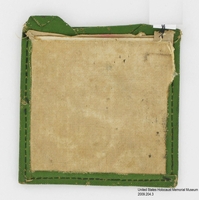
Cloth work pass with an embroidered blue W used to exit and enter the Lvov ghetto
Object
Embroidered work pass with a green border inside a plastic holder worn by Salomon Goldman to exit and return to the Lvov ghetto in German occupied Poland from 1941-43, for his job as an accountant at a slaughterhouse and tanning factory. He and his wife Gusta and daughter Ilona fled Krakow for Russian controlled Lvov (Lviv, Ukraine), soon after the German invasion in September 1939. When Germany invaded the Soviet Union in 1941 and occupied Lvov, the Wehrmacht took over the factory. After several months, Salomon and his family were forced to move into the Jewish ghetto. In the spring of 1942, fearing liquidation of the ghetto, Salomon was offered a hiding place by a former employee, Jozef Jozak. His Russian Orthodox wife Rozalie did not want them in their home and they would not hide Ilona because they thought it would be too hard to conceal a lively 2 year-old child. Ilona was smuggled out to the countryside and placed in hiding as a Christian child with a Polish woman, Hania Seremet, paid to hide her. After 6 months, they could no longer pay for her care, and Hania dumped Ilona back with her parents, without the knowledge of the Jozak family. The three had to stay hidden nearly all the time in one small room. The family lived in hiding until the Soviet Army liberated the city in July 1944. When the was ended in May 1945, they returned to Krakow.
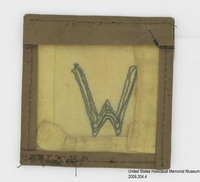
Cloth work pass with an embroidered black W used to enter and exit the Lvov ghetto
Object
Embroidered work pass with a brown border in a plastic holder used by Salomon Goldman to exit and return to the Lvov ghetto in German occupied Poland from 1941-43, for his job as an accountant at a slaughterhouse and tanning factory. He and his wife Gusta and daughter Ilona fled Krakow for Russian controlled Lvov (Lviv, Ukraine), soon after the German invasion in September 1939. When Germany invaded the Soviet Union in 1941 and occupied Lvov, the Wehrmacht took over the factory. After several months, Salomon and his family were forced to move into the Jewish ghetto. In the spring of 1942, fearing liquidation of the ghetto, Salomon was offered a hiding place by a former employee, Jozef Jozak. His Russian Orthodox wife Rozalie did not want them in their home and they would not hide Ilona because they thought it would be too hard to conceal a lively 2 year-old child. Ilona was smuggled out to the countryside and placed in hiding as a Christian child with a Polish woman, Hania Seremet, paid to hide her. After 6 months, they could no longer pay for her care, and Hania dumped Ilona back with her parents, without the knowledge of the Jozak family. The three had to stay hidden nearly all the time in one small room. The family lived in hiding until the Soviet Army liberated the city in July 1944. When the was ended in May 1945, they returned to Krakow.
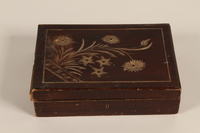
Wooden box with carved floral decorations used by a hidden child
Object
Wooden box with carved flowers used by Ilona Goldman to store the drawings that she made while in hiding in Lvov, Poland (L'viv, Ukraine) from 1942-1944. The box may have originally belonged to a Jewish man who came daily from the ghetto to work in the factory where Ilona's father worked. Ilona's family lived at the factory and this man begged her mother to keep a locked wooden box with carved flowers for a few days. She uncomfortably said yes and he told her that if he did not return in a month, the contents were hers. He unlocked it to show it was filled with jewels. He came back two weeks later and told Gusta to take what she liked. She chose a small gold pin with diamonds. He dumped the contents into a bag around his neck and left. Ilona and her parents Gusta and Salomon fled Krakow for Russian controlled Lvov (Lviv, Ukraine), soon after the German invasion in September 1939. When Germany invaded the Soviet Union in 1941 and occupied Lvov, the Wehrmacht took over the factory. After several months, Salomon and his family were forced to move into the Jewish ghetto. In spring 1942, fearing liquidation of the ghetto, Salomon was offered a hiding place by a former employee, Jozef Jozak. His Russian Orthodox wife Rozalie did not want them in their home and they would not hide Ilona because they thought it would be too hard to conceal a lively 2 year-old child. Ilona was smuggled out to the countryside and placed in hiding as a Christian child with a Polish woman, Hania Seremet, paid to hide her. After 6 months, they could no longer pay for her care, and Hania dumped Ilona back with her parents, without the knowledge of the Jozak family. The three had to stay hidden nearly all the time in one small room. The family lived in hiding until the Soviet Army liberated the city in July 1944. When the was ended in May 1945, they returned to Krakow.
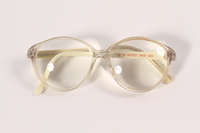
Clear and white plastic eyeglasses worn by a Jewish emigrant
Object
White plastic eyeglasses worn by Gusta Goldman in Israel after she and her family immigrated from Krakow, Poland, in December 1949. Soon after Nazi Germany invaded Poland in September 1939, Gusta and Salomon, with two year old, Ilona, fled Krakow for Russian controlled Lvov (Lviv, Ukraine). When Germany invaded the Soviet Union in 1941, the family was forced into the ghetto. Salomon worked as an accountant at a factory owned by the Wehrmacht. In the spring of 1942, fearing the liquidation of the ghetto, Salomon arranged a hiding place for them outside the ghetto with a former employee, Jozef Jozak. However, he would not hide Ilona because it would be too hard to conceal a lively 2 year-old child. Ilona was smuggled out to the countryside and placed in hiding as a Christian child, with a Polish woman, Hania Seremet, who was paid to hide her. After 6 months, they could no longer pay for her care, and Hania dumped Ilona back with her parents, without the knowledge of the Jozak family. The three had to stay hidden nearly all the time in one small room. The family lived in hiding until the Soviet Army liberated the city in July 1944. When the was ended in May 1945, they returned to Krakow.
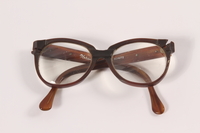
Brown plastic eyeglasses worn by a Jewish resident of the Lvov ghetto
Object
Brown plastic eyeglasses that may have been worn by Gusta Goldman while she lived in hiding in Lvov, Poland, from 1942-1944. Soon after Nazi Germany invaded Poland in September 1939, Gusta and Salomon, with two year old, Ilona, fled Krakow for Russian controlled Lvov (Lviv, Ukraine). When Germany invaded the Soviet Union in 1941, the family was forced into the ghetto. Salomon worked as an accountant at a factory owned by the Wehrmacht. In the spring of 1942, fearing the liquidation of the ghetto, Salomon arranged a hiding place for them outside the ghetto with a former employee, Jozef Jozak. However, he would not hide Ilona because it would be too hard to conceal a lively 2 year-old child. Ilona was smuggled out to the countryside and placed in hiding as a Christian child, with a Polish woman, Hania Seremet, who was paid to hide her. After 6 months, they could no longer pay for her care, and Hania dumped Ilona back with her parents, without the knowledge of the Jozak family. The three had to stay hidden nearly all the time in one small room. The family lived in hiding until the Soviet Army liberated the city in July 1944. When the was ended in May 1945, they returned to Krakow.
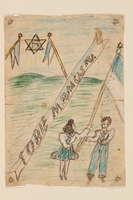
Color drawing of a boy and girl holding a blue and white flag created by a hidden child
Object
Colored pencil drawing of a boy and girl holding a blue and white flag, the national colors of Israel, with a large Star of David created by Ilona Goldman around 1947. During the war, Ilona lived in hiding in Poland from 1942-1944. She made many drawings during this time, especially when, at age four, she was separated from her parents and placed with the Polish peasant family of Hania Seremet, who agreed to hide her for a fee. Drawings were the only way for the talkative child, not yet able to write, to communicate with her parents. After Nazi Germany invaded Poland in September 1939, Ilona with her parents, Salomon and Gusta fled Krakow for Soviet controlled Lvov (Lviv, Ukraine). When Germany invaded the Soviet Union in 1941, the family was confined in the Jewish ghetto where Salomon worked as an accountant at a meat rendering factory owned by the Wehrmacht. In spring 1942, fearing the liquidation of the ghetto, Salomon arranged a hiding place for them outside the ghetto with a former employee, Jozef Jozak, and his family. However, they would not hide Ilona because they thought it would be too hard to conceal a lively young girl. Ilona was smuggled to the countryside and placed in hiding as a Christian child with the Seremets. After 6 months, Salomon could no longer pay for her care, so Ilona was brought back to live in their hiding place, without the knowledge of the Jozak family. Ilona had to stay most of this time locked in a closet with only her drawings and medical textbooks left by a previous tenant. The family lived in hiding until the Soviet Army liberated the city in July 1944. When the war ended in May 1945, they returned to Krakow.
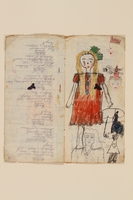
Pages from a record book with sketches created by a hidden child
Object
Four pages from a record book with colored pencil drawings created by 5 year old Ilona Goldman while living in hiding in Poland from 1942-1944. A few pages are covered with drawings and doodles by Ilona. Most pages have Polish writing in an adult hand, some of these have small drawings by Ilona. In spring 1942, Ilona was separated from her parents and placed with the Polish peasant family of Hania Seremet, who agreed to hide Ilona for a fee. Drawings were the only way for the talkative child, not yet able to write, to communicate with her parents. Many drawings were done on the weekly letters Hania sent to Ilona's parents. After Nazi Germany invaded Poland in September 1939, Ilona, with her parents, Salomon and Gusta fled Krakow for Soviet controlled Lvov (Lviv, Ukraine). When Germany invaded the Soviet Union in 1941, the family was forced into the Jewish ghetto where Salomon worked as an accountant at a meat factory owned by the Wehrmacht. In spring 1942, fearing the liquidation of the ghetto, Salomon arranged a hiding place for them outside the ghetto with a former employee, Jozef Jozak. However, he would not hide Ilona because it would be too hard to conceal a lively 4 year-old. Ilona was smuggled to the countryside and placed in hiding as a Christian child with a Polish woman paid to hide her. After 6 months, Salomon could no longer pay for her care, so Ilona was brought back to live in their hiding place, without the knowledge of the Jozak family. Ilona had to stay most of this time locked in a closet with only her drawings and medical textbooks left by a previous tenant. The family lived in hiding until the Soviet Army liberated the city in July 1944. When the war ended in May 1945, they returned to Krakow.
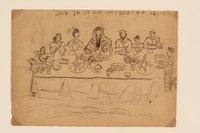
Pencil drawing of people seated for Seder created by a former hidden child
Object
Pencil sketch of people seated for Seder dinner created by Ilona Goldman after the war. During the war, Ilona lived in hiding in Poland from 1942-1944. She made many drawings during this time, especially when, at age four, she was separated from her parents and placed with the Polish peasant family of Hania Seremet, who agreed to hide her for a fee. Drawings were the only way for the talkative child, not yet able to write, to communicate with her parents. After Nazi Germany invaded Poland in September 1939, Ilona with her parents, Salomon and Gusta fled Krakow for Soviet controlled Lvov (Lviv, Ukraine). When Germany invaded the Soviet Union in 1941, the family was confined in the Jewish ghetto where Salomon worked as an accountant at a meat rendering factory owned by the Wehrmacht. In spring 1942, fearing the liquidation of the ghetto, Salomon arranged a hiding place for them outside the ghetto with a former employee, Jozef Jozak, and his family. However, they would not hide Ilona because they thought it would be too hard to conceal a lively young girl. Ilona was smuggled to the countryside and placed in hiding as a Christian child with the Seremets. After 6 months, Salomon could no longer pay for her care, so Ilona was brought back to live in their hiding place, without the knowledge of the Jozak family. Ilona had to stay most of this time locked in a closet with only her drawings and medical textbooks left by a previous tenant. The family lived in hiding until the Soviet Army liberated the city in July 1944. When the war ended in May 1945, they returned to Krakow.
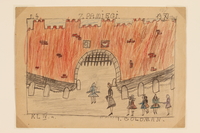
Color drawing of girls visiting a medieval castle created by a former hidden child
Object
Colored pencil drawing of a group of young girls visiting a medieval castle created by 10 year old Ilona Goldman in November 1947. In spring 1942, 4 year old Ilona was separated from her parents and placed with the Polish peasant family of Hania Seremet, who agreed to hide her for a fee. Drawings were the only way for the talkative child, not yet able to write, to communicate with her parents. After Nazi Germany invaded Poland in September 1939, Ilona's parents, Salomon and Gusta, with Ilona, fled Krakow for Soviet controlled Lvov (Lviv, Ukraine). When Germany invaded the Soviet Union in 1941, the family was forced into the Jewish ghetto where Salomon worked as an accountant at a meat factory owned by the Wehrmacht. In spring 1942, fearing the liquidation of the ghetto, Salomon arranged a hiding place for them outside the ghetto with a former employee, Jozef Jozak. However, he would not hide Ilona because it would be too hard to conceal a lively 4 year-old. Ilona was smuggled to the countryside and placed in hiding as a Christian child with a Polish woman paid to hide her. After 6 months, Salomon could no longer pay for her care, so Ilona was brought back to live in their hiding place, without the knowledge of the Jozak family. Ilona had to stay most of this time locked in a closet with only her drawings and the medical textbooks left by a previous tenant. The family lived in hiding until the Soviet Army liberated the city in July 1944. When the war ended in May 1945, they returned to Krakow.
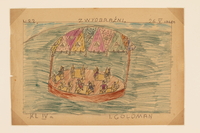
Color drawing of children seated within a gazebo created by a former hidden child
Object
Colored pencil drawing of a children seated on benches with a gazebo created by 11 year old Ilona Goldman in 1948. During the war, Ilona lived in hiding in Poland from 1942-1944. She made many drawings during this time, especially when, in spring 1942 at age four, she was separated from her parents and placed with the Polish peasant family of Hania Seremet, who agreed to hide her for a fee. These drawings were the only way for the talkative child, not yet able to write, to communicate with her parents. After Nazi Germany invaded Poland in September 1939, Ilona with her parents, Salomon and Gusta fled Krakow for Soviet controlled Lvov (Lviv, Ukraine). When Germany invaded the Soviet Union in 1941, the family was forced into the Jewish ghetto where Salomon worked as an accountant at a meat factory owned by the Wehrmacht. In spring 1942, fearing the liquidation of the ghetto, Salomon arranged a hiding place for them outside the ghetto with a former employee, Jozef Jozak. However, he would not hide Ilona because it would be too hard to conceal a lively young girl. Ilona was smuggled to the countryside and placed in hiding as a Christian child with the Seremets. After 6 months, Salomon could no longer pay for her care, so Ilona was brought back to live in their hiding place, without the knowledge of the Jozak family. Ilona had to stay most of this time locked in a closet with only her drawings and the medical textbooks left by a previous tenant. The family lived in hiding until the Soviet Army liberated the city in July 1944. When the war ended in May 1945, they returned to Krakow.
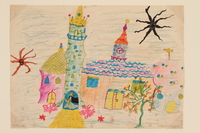
Watercolor of a black haired princess in a castle doorway created by a former hidden child
Object
Watercolor and pencil drawing of a princess and a row of exotic buildings created by 11 year old Ilona Goldman in 1948. During the war, Ilona lived in hiding in Poland from 1942-1944. She made many drawings during this time, especially when, in spring 1942 at age four, she was separated from her parents and placed with the Polish peasant family of Hania Seremet, who agreed to hide her for a fee. These drawings were the only way for the talkative child, not yet able to write, to communicate with her parents. After Nazi Germany invaded Poland in September 1939, Ilona with her parents, Salomon and Gusta fled Krakow for Soviet controlled Lvov (Lviv, Ukraine). When Germany invaded the Soviet Union in 1941, the family was forced into the Jewish ghetto where Salomon worked as an accountant at a meat factory owned by the Wehrmacht. In spring 1942, fearing the liquidation of the ghetto, Salomon arranged a hiding place for them outside the ghetto with a former employee, Jozef Jozak. However, he would not hide Ilona because it would be too hard to conceal a lively young girl. Ilona was smuggled to the countryside and placed in hiding as a Christian child with the Seremets. After 6 months, Salomon could no longer pay for her care, so Ilona was brought back to live in their hiding place, without the knowledge of the Jozak family. Ilona had to stay most of this time locked in a closet with only her drawings and the medical textbooks left by a previous tenant. The family lived in hiding until the Soviet Army liberated the city in July 1944. When the war ended in May 1945, they returned to Krakow.
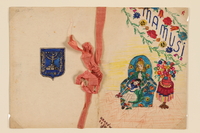
Mother's Day card with ribbon and an image of a mother and daughter created by a former hidden child
Object
Handmade Mother's Day card tied with a pink ribbon created by 12 year old Ilona Goldman in 1949. It has a handwritten message inside wishing her mother joy, happiness, and good health. During the war, Ilona lived in hiding in Poland from 1942-1944. She made many drawings during this time, especially when, in spring 1942 at age four, she was separated from her parents and placed with the Polish peasant family of Hania Seremet, who agreed to hide her for a fee. Drawings were the only way for the talkative child, not yet able to write, to communicate with her parents. After Nazi Germany invaded Poland in September 1939, Ilona with her parents, Salomon and Gusta fled Krakow for Soviet controlled Lvov (Lviv, Ukraine). When Germany invaded the Soviet Union in 1941, the family was confined in the Jewish ghetto where Salomon worked as an accountant at a meat rendering factory owned by the Wehrmacht. In spring 1942, fearing the liquidation of the ghetto, Salomon arranged a hiding place for them outside the ghetto with a former employee, Jozef Jozak. However, they would not hide Ilona because he thought it would be too hard to conceal a lively young girl. Ilona was smuggled to the countryside and placed in hiding as a Christian child with the Seremets. After 6 months, Salomon could no longer pay for her care, so Ilona was brought back to live in their hiding place, without the knowledge of the Jozak family. Ilona had to stay most of this time locked in a closet with only her drawings and medical textbooks left by a previous tenant. The family lived in hiding until the Soviet Army liberated the city in July 1944. When the war ended in May 1945, they returned to Krakow.
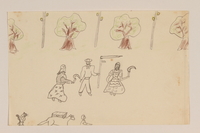
Pencil sketch of animals following a child past a farm family created by a hidden child
Object
Pencil sketch of a farming family with a partial view of a puss in boots, a dog with a suitcase, and a girl created by 6 year old Ilona Goldman perhaps around 1944. See 2009.204.25 for a more detailed version of this scene. In spring 1942, Ilona was separated from her parents and placed with the Polish peasant family of Hania Seremet, who agreed to hide Ilona for a fee. Drawings were the only way for the talkative child, not yet able to write, to communicate with her parents. Many drawings were done on the weekly letters Hania sent to Ilona's parents. After Nazi Germany invaded Poland in September 1939, Ilona and her parents, Salomon and Gusta, fled Krakow for Soviet controlled Lvov (Lviv, Ukraine). When Germany invaded the Soviet Union in 1941, the family was forced into the Jewish ghetto where Salomon worked as an accountant at a meat factory owned by the Wehrmacht. In spring 1942, fearing the liquidation of the ghetto, Salomon arranged a hiding place for them outside the ghetto with a former employee, Jozef Jozak. However, he would not hide Ilona because it would be too hard to conceal a lively 4 year-old. Ilona was smuggled to the countryside and placed in hiding as a Christian child with Hania. After 6 months, Salomon could no longer pay for her care, so Ilona was brought back to live in their hiding place, without the knowledge of the Jozak family. Ilona had to stay most of this time locked in a closet with only her drawings and medical textbooks left by a previous tenant. The family lived in hiding until the Soviet Army liberated the city in July 1944. When the war ended in May 1945, they returned to Krakow.
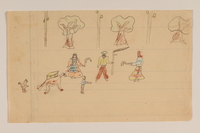
Color drawing of animals following a child past a farm family created by a hidden child
Object
Pencil and pastel drawing of a puss in boots, a dog with a suitcase, and a family with farm tools created by 6 year old Ilona Goldman while living in hiding in Poland from 1942-1944. See 2009.204.24 for a less polished version of this scene. In spring 1942, Ilona was separated from her parents and placed with the Polish peasant family of Hania Seremet, who agreed to hide Ilona for a fee. Drawings were the only way for the talkative child, not yet able to write, to communicate with her parents. Many drawings were done on the weekly letters Hania sent to Ilona's parents. After Nazi Germany invaded Poland in September 1939, Ilona and her parents, Salomon and Gusta, fled Krakow for Soviet controlled Lvov (Lviv, Ukraine). When Germany invaded the Soviet Union in 1941, the family was forced into the Jewish ghetto where Salomon worked as an accountant at a meat factory owned by the Wehrmacht. In spring 1942, fearing the liquidation of the ghetto, Salomon arranged a hiding place for them outside the ghetto with a former employee, Jozef Jozak. However, he would not hide Ilona because it would be too hard to conceal a lively 4 year-old. Ilona was smuggled to the countryside and placed in hiding as a Christian child with Hania. After 6 months, Salomon could no longer pay for her care, so Ilona was brought back to live in their hiding place, without the knowledge of the Jozak family. Ilona had to stay most of this time locked in a closet with only her drawings and medical textbooks left by a previous tenant. The family lived in hiding until the Soviet Army liberated the city in July 1944. When the war ended in May 1945, they returned to Krakow.
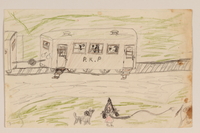
Color drawing of a girl and a train created by a hidden child
Object
Pencil and pastel drawing of a girl, animals, and a train created by 6 year old Ilona Goldman while living in hiding in Poland from 1942-1944. In spring 1942, Ilona was separated from her parents and placed with the Polish peasant family of Hania Seremet, who agreed to hide Ilona for a fee. Drawings were the only way for the talkative child, not yet able to write, to communicate with her parents. Many drawings were done on the weekly letters Hania sent to Ilona's parents. After Nazi Germany invaded Poland in September 1939, Ilona and her parents, Salomon and Gusta, fled Krakow for Soviet controlled Lvov (Lviv, Ukraine). When Germany invaded the Soviet Union in 1941, the family was forced into the Jewish ghetto where Salomon worked as an accountant at a meat factory owned by the Wehrmacht. In spring 1942, fearing the liquidation of the ghetto, Salomon arranged a hiding place for them outside the ghetto with a former employee, Jozef Jozak. However, he would not hide Ilona because it would be too hard to conceal a lively 4 year-old. Ilona was smuggled to the countryside and placed in hiding as a Christian child with Hania. After 6 months, Salomon could no longer pay for her care, so Ilona was brought back to live in their hiding place, without the knowledge of the Jozak family. Ilona had to stay most of this time locked in a closet with only her drawings and medical textbooks left by a previous tenant. The family lived in hiding until the Soviet Army liberated the city in July 1944. When the war ended in May 1945, they returned to Krakow.
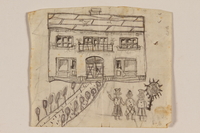
Sketch of a house on the back of a letter sent for a hidden child
Object
Pencil sketch of three girls in front of a house with a letter on the back dated July 1, 1944 created by Ilona Goldman and her father Salomon while living in hiding in Lvov, Poland (Lviv, Ukraine). The drawing is by 6 year old Ilona with architectural details added by her father. The text is a story she dictated to her father about a girl, her Mommy, and a cat with everyone returning home at the end. Ilona lived in hiding in Poland from 1942-1944. In spring 1942, at age 4, she was separated from her parents and placed with the Polish peasant family of Hania Seremet, who agreed to hide her for a fee. Drawings were the only way for the talkative child, not yet able to write, to communicate with her parents. After Nazi Germany invaded Poland in September 1939, Ilona and her parents, Salomon and Gusta, fled Krakow for Russian controlled Lvov. When Germany invaded the Soviet Union in 1941, the family was forced into the Jewish ghetto where Salomon worked as an accountant at a meat factory owned by the Wehrmacht. In spring 1942, fearing the liquidation of the ghetto, Salomon arranged a hiding place for them outside the ghetto with a former employee, Jozef Jozak. However, he would not hide Ilona because he thought it would be too hard to conceal a lively 4 year-old. Ilona was smuggled to the countryside and placed in hiding as a Christian child with Hania. After 6 months, Salomon could no longer pay for her care, so Ilona was brought back to live in their hiding place, without the knowledge of the Jozak family. Ilona had to stay most of this time locked in a closet with only her drawings and the medical textbooks left by a previous tenant. The family lived in hiding until the Soviet Army liberated the city in July 1944. When the war ended in May 1945, they returned to Krakow.
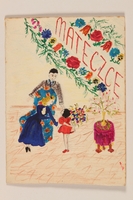
Birthday card with a message and family portrait by a former hidden child
Object
Handmade birthday card with a family portrait and an inscription created for her mother by 12 year old Ilona Goldman in 1949. During the war, Ilona lived in hiding in Poland from 1942-1944. She made many drawings during this time, especially when, in spring 1942 at age four, she was separated from her parents and placed with the Polish peasant family of Hania Seremet, who agreed to hide her for a fee. These drawings were the only way for the talkative child, not yet able to write, to communicate with her parents. After Nazi Germany invaded Poland in September 1939, Ilona with her parents, Salomon and Gusta, fled Krakow for Soviet controlled Lvov (Lviv, Ukraine). When Germany invaded the Soviet Union in 1941, the family was forced into the Jewish ghetto where Salomon worked as an accountant at a meat rendering factory owned by the Wehrmacht. In spring 1942, fearing the liquidation of the ghetto, Salomon arranged a hiding place for them outside the ghetto with a former employee, Jozef Jozak. However, he would not hide Ilona because it would be too hard to conceal a lively young girl. Ilona was smuggled to the countryside and placed in hiding as a Christian child with the Seremets. After 6 months, Salomon could no longer pay for her care, so Ilona was brought back to live in their hiding place, without the knowledge of the Jozak family. Ilona had to stay most of this time locked in a closet with only her drawings and the medical textbooks left by a previous tenant. The family lived in hiding until the Soviet Army liberated the city in July 1944. When the war ended in May 1945, they returned to Krakow.
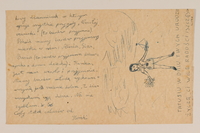
Birthday letter with a drawing of a girl with flowers and a toy boat created by a former hidden child
Object
Letter with birthday greetings and a drawing of a girl with flowers and a toy sailboat created by Ilona Goldman for her father after the war. The letter tells of her stay in summer camp where she shares a room with three girls and has a young woman as camp counselor. Ilona lived in hiding in Poland from 1942-1944. In spring 1942, at age four, she was separated from her parents and placed with the Polish peasant family of Hania Seremet, who agreed to hide her for a fee. Drawings were the only way for the talkative child, not yet able to write, to communicate with her parents. After Nazi Germany invaded Poland in September 1939, Ilona with her parents, Salomon and Gusta, fled Krakow for Soviet controlled Lvov (Lviv, Ukraine). When Germany invaded the Soviet Union in 1941, the family was forced into the Jewish ghetto where Salomon worked as an accountant at a meat factory owned by the Wehrmacht. In spring 1942, fearing the liquidation of the ghetto, Salomon arranged a hiding place for them outside the ghetto with a former employee, Jozef Jozak. However, he would not hide Ilona because it would be too hard to conceal a lively young girl. Ilona was smuggled to the countryside and placed in hiding as a Christian child with the Seremets. After 6 months, Salomon could no longer pay for her care, so Ilona was brought back to live in their hiding place, without the knowledge of the Jozak family. Ilona had to stay most of this time locked in a closet with only her drawings and the medical textbooks left by a previous tenant. The family lived in hiding until the Soviet Army liberated the city in July 1944. When the war ended in May 1945, they returned to Krakow.
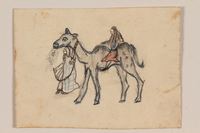
Small color drawing of a man leading a camel with rider created by a former hidden child
Object
Colored pencil drawing of a bearded man in a robe and headscarf leading a camel with rider created by 5 year old Ilona Goldman while living in hiding in Poland from 1942-1944. In spring 1942, Ilona was separated from her parents and placed with the Polish peasant family of Hania Seremet, who agreed to hide Ilona for a fee. These drawings were the only way for the talkative child, not yet able to write, to communicate with her parents. Many drawings were done on the weekly letters Hania sent to Ilona's parents. After Nazi Germany invaded Poland in September 1939, Ilona and her parents, Salomon and Gusta, fled Krakow for Russian controlled Lvov (Lviv, Ukraine). When Germany invaded the Soviet Union in 1941, the family was forced into the Jewish ghetto where Salomon worked as an accountant at a meat factory owned by the Wehrmacht. In spring 1942, fearing the liquidation of the ghetto, Salomon arranged a hiding place for them outside the ghetto with a former employee, Jozef Jozak. However, he would not hide Ilona because it would be too hard to conceal a lively 4 year-old. Ilona was smuggled to the countryside and placed in hiding as a Christian child with a Polish woman paid to hide her. After 6 months, Salomon could no longer pay for her care, so Ilona was brought back to live in their hiding place, without the knowledge of the Jozak family. Ilona had to stay most of this time locked in a closet with only her drawings and medical textbooks left by a previous tenant. The family lived in hiding until the Soviet Army liberated the city in July 1944. When the war ended in May 1945, they returned to Krakow.
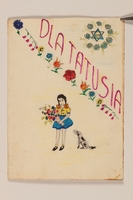
Birthday card depicting a little girl and a dog made for her father by a former hidden child
Object
Birthday card with a drawing of a girl and a spotted dog with a written message created for her father by 12 year old Ilona Goldman in Krakow in 1949. During the war, Ilona lived in hiding in Poland from 1942-1944. She made many drawings during this time, especially when, in spring 1942 at age four, she was separated from her parents and placed with the Polish peasant family of Hania Seremet, who agreed to hide her for a fee. These drawings were the only way for the talkative child, not yet able to write, to communicate with her parents. After Nazi Germany invaded Poland in September 1939, Ilona with her parents, Salomon and Gusta, fled Krakow for Soviet controlled Lvov (Lviv, Ukraine). When Germany invaded the Soviet Union in 1941, the family was forced into the Jewish ghetto where Salomon worked as an accountant at a meat rendering factory owned by the Wehrmacht. In spring 1942, fearing the liquidation of the ghetto, Salomon arranged a hiding place for them outside the ghetto with a former employee, Jozef Jozak. However, he would not hide Ilona because it would be too hard to conceal a lively young girl. Ilona was smuggled to the countryside and placed in hiding as a Christian child with the Seremets. After 6 months, Salomon could no longer pay for her care, so Ilona was brought back to live in their hiding place, without the knowledge of the Jozak family. Ilona had to stay most of this time locked in a closet with only her drawings and the medical textbooks left by a previous tenant. The family lived in hiding until the Soviet Army liberated the city in July 1944. When the war ended in May 1945, they returned to Krakow.
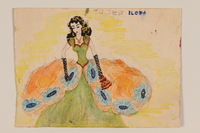
Watercolor of a black haired young woman in a ball gown created by a hidden child
Object
Watercolor of a dark haired woman in a beautiful green gown created by or for 12 year old Ilona Goldman in 1949. During the war, Ilona lived in hiding in Poland from 1942-1944. She made many drawings during this time, especially when, in spring 1942 at age four, she was separated from her parents and placed with the Polish peasant family of Hania Seremet, who agreed to hide her for a fee. These drawings were the only way for the talkative child, not yet able to write, to communicate with her parents. After Nazi Germany invaded Poland in September 1939, Ilona with her parents, Salomon and Gusta, fled Krakow for Soviet controlled Lvov (Lviv, Ukraine). When Germany invaded the Soviet Union in 1941, the family was forced into the Jewish ghetto where Salomon worked as an accountant at a meat rendering factory owned by the Wehrmacht. In spring 1942, fearing the liquidation of the ghetto, Salomon arranged a hiding place for them outside the ghetto with a former employee, Jozef Jozak. However, he would not hide Ilona because it would be too hard to conceal a lively young girl. Ilona was smuggled to the countryside and placed in hiding as a Christian child with the Seremets. After 6 months, Salomon could no longer pay for her care, so Ilona was brought back to live in their hiding place, without the knowledge of the Jozak family. Ilona had to stay most of this time locked in a closet with only her drawings and the medical textbooks left by a previous tenant. The family lived in hiding until the Soviet Army liberated the city in July 1944. When the war ended in May 1945, they returned to Krakow.
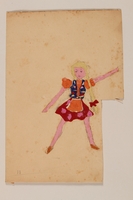
Colorful paper doll of a young girl created by a hidden child
Object
Paper doll of a young girl with blond braids and red skirt with hearts created by 6 year old Ilona Goldman while living in hiding from 1942-1944 or just after the war. Ilona had few toys and made many small paper dolls with different outfits to play with. After Nazi Germany invaded Poland in September 1939, Ilona, with her parents, Salomon and Gusta, fled Krakow for Soviet controlled Lvov (Lviv, Ukraine). When Germany invaded the Soviet Union in 1941, the family was forced into the Jewish ghetto where Salomon worked as an accountant at a meat rendering factory owned by the Wehrmacht. In spring 1942, fearing the liquidation of the ghetto, Salomon arranged a hiding place for them outside the ghetto with a former employee, Jozef Jozak. However, he would not hide Ilona because it would be too hard to conceal a lively young girl. Ilona, age 2, was smuggled to the country and placed in hiding as a Christian child with the Polish peasant family of Hania Seremet, who agreed to hide her for a fee. After 6 months, Salomon could no longer pay for her care, so Ilona was brought back to live in their hiding place, without the knowledge of the Jozak family. Ilona had to stay most of this time locked in a closet with only her drawings and the medical textbooks left by a previous tenant. The family lived in hiding until the Soviet Army liberated the city in July 1944. When the war ended in May 1945, they returned to Krakow.
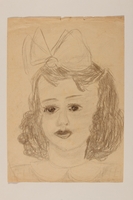
Charcoal portrait of a young girl created by a hidden child
Object
Charcoal portrait of a young girl with a big bow in her dark hair created by Ilona Goldman. During the war, Ilona lived in hiding in Poland from 1942-1944. She made many drawings during this time, especially when, in spring 1942 at age four, she was separated from her parents and placed with the Polish peasant family of Hania Seremet, who agreed to hide her for a fee. These drawings were the only way for the talkative child, not yet able to write, to communicate with her parents. After Nazi Germany invaded Poland in September 1939, Ilona with her parents, Salomon and Gusta, fled Krakow for Soviet controlled Lvov (Lviv, Ukraine). When Germany invaded the Soviet Union in 1941, the family was forced into the Jewish ghetto where Salomon worked as an accountant at a meat rendering factory owned by the Wehrmacht. In spring 1942, fearing the liquidation of the ghetto, Salomon arranged a hiding place for them outside the ghetto with a former employee, Jozef Jozak. However, he would not hide Ilona because it would be too hard to conceal a lively young girl. Ilona was smuggled to the countryside and placed in hiding as a Christian child with the Seremets. After 6 months, Salomon could no longer pay for her care, so Ilona was brought back to live in their hiding place, without the knowledge of the Jozak family. Ilona had to stay most of this time locked in a closet with only her drawings and the medical textbooks left by a previous tenant. The family lived in hiding until the Soviet Army liberated the city in July 1944. When the war ended in May 1945, they returned to Krakow.
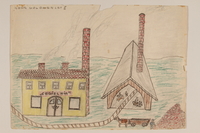
Color drawing of a brick factory created by a former hidden child
Object
Pastel drawing of factories created for a school project by 9 year old Ilona Goldman in 1946. During the war, Ilona lived in hiding in Poland from 1942-1944. She made many drawings during this time, especially when, in spring 1942 at age four, she was separated from her parents and placed with the Polish peasant family of Hania Seremet, who agreed to hide her for a fee. These drawings were the only way for the talkative child, not yet able to write, to communicate with her parents. After Nazi Germany invaded Poland in September 1939, Ilona with her parents, Salomon and Gusta, fled Krakow for Soviet controlled Lvov (Lviv, Ukraine). When Germany invaded the Soviet Union in 1941, the family was forced into the Jewish ghetto where Salomon worked as an accountant at a meat rendering factory owned by the Wehrmacht. In spring 1942, fearing the liquidation of the ghetto, Salomon arranged a hiding place for them outside the ghetto with a former employee, Jozef Jozak. However, he would not hide Ilona because it would be too hard to conceal a lively young girl. Ilona was smuggled to the countryside and placed in hiding as a Christian child with the Seremets. After 6 months, Salomon could no longer pay for her care, so Ilona was brought back to live in their hiding place, without the knowledge of the Jozak family. Ilona had to stay most of this time locked in a closet with only her drawings and the medical textbooks left by a previous tenant. The family lived in hiding until the Soviet Army liberated the city in July 1944. When the war ended in May 1945, they returned to Krakow.Soviet Army liberated the city in July 1944. When the war ended in May 1945, they returned to Krakow.
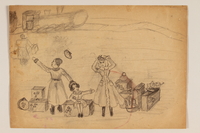
Pencil drawing of a family at a train station created by a former hidden child
Object
Pencil drawing of a family at a train station created by Ilona Goldman after the war. During the war, Ilona lived in hiding in Poland from 1942-1944. She made many drawings during this time, especially when, in spring 1942 at age four, she was separated from her parents and placed with the Polish peasant family of Hania Seremet, who agreed to hide her for a fee. These drawings were the only way for the talkative child, not yet able to write, to communicate with her parents. After Nazi Germany invaded Poland in September 1939, Ilona with her parents, Salomon and Gusta, fled Krakow for Soviet controlled Lvov (Lviv, Ukraine). When Germany invaded the Soviet Union in 1941, the family was forced into the Jewish ghetto where Salomon worked as an accountant at a meat rendering factory owned by the Wehrmacht. In spring 1942, fearing the liquidation of the ghetto, Salomon arranged a hiding place for them outside the ghetto with a former employee, Jozef Jozak. However, he would not hide Ilona because it would be too hard to conceal a lively young girl. Ilona was smuggled to the countryside and placed in hiding as a Christian child with the Seremets. After 6 months, Salomon could no longer pay for her care, so Ilona was brought back to live in their hiding place, without the knowledge of the Jozak family. Ilona had to stay most of this time locked in a closet with only her drawings and the medical textbooks left by a previous tenant. The family lived in hiding until the Soviet Army liberated the city in July 1944. When the war ended in May 1945, they returned to Krakow.
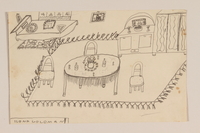
Pencil drawing of a furnished room created by a former hidden child
Object
Detailed pencil drawing of a furnished room created by Ilona Goldman while in hiding. During the war, Ilona lived in hiding in Poland from 1942-1944. She made many drawings during this time, especially when, in spring 1942 at age four, she was separated from her parents and placed with the Polish peasant family of Hania Seremet, who agreed to hide her for a fee. These drawings were the only way for the talkative child, not yet able to write, to communicate with her parents. After Nazi Germany invaded Poland in September 1939, Ilona with her parents, Salomon and Gusta, fled Krakow for Soviet controlled Lvov (Lviv, Ukraine). When Germany invaded the Soviet Union in 1941, the family was forced into the Jewish ghetto where Salomon worked as an accountant at a meat rendering factory owned by the Wehrmacht. In spring 1942, fearing the liquidation of the ghetto, Salomon arranged a hiding place for them outside the ghetto with a former employee, Jozef Jozak. However, he would not hide Ilona because it would be too hard to conceal a lively young girl. Ilona was smuggled to the countryside and placed in hiding as a Christian child with the Seremets. After 6 months, Salomon could no longer pay for her care, so Ilona was brought back to live in their hiding place, without the knowledge of the Jozak family. Ilona had to stay most of this time locked in a closet with only her drawings and the medical textbooks left by a previous tenant. The family lived in hiding until the Soviet Army liberated the city in July 1944. When the war ended in May 1945, they returned to Krakow.
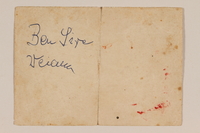
Brief note belonging to a hidden child
Object
Notecard with three words written in blue ink possbily by Ilona Goldman's caregiver when she lived in hiding. During the war, Ilona lived in hiding in Poland from 1942-1944. She made many drawings during this time, especially when, in spring 1942 at age four, she was separated from her parents and placed with the Polish peasant family of Hania Seremet, who agreed to hide her for a fee. These drawings were the only way for the talkative child, not yet able to write, to communicate with her parents. After Nazi Germany invaded Poland in September 1939, Ilona with her parents, Salomon and Gusta, fled Krakow for Soviet controlled Lvov (Lviv, Ukraine). When Germany invaded the Soviet Union in 1941, the family was forced into the Jewish ghetto where Salomon worked as an accountant at a meat rendering factory owned by the Wehrmacht. In spring 1942, fearing the liquidation of the ghetto, Salomon arranged a hiding place for them outside the ghetto with a former employee, Jozef Jozak. However, he would not hide Ilona because it would be too hard to conceal a lively young girl. Ilona was smuggled to the countryside and placed in hiding as a Christian child with the Seremets. After 6 months, Salomon could no longer pay for her care, so Ilona was brought back to live in their hiding place, without the knowledge of the Jozak family. Ilona had to stay most of this time locked in a closet with only her drawings and the medical textbooks left by a previous tenant. The family lived in hiding until the Soviet Army liberated the city in July 1944. When the war ended in May 1945, they returned to Krakow.
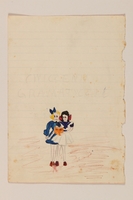
Color drawing of two girls with a book created by a former hidden child
Object
Colored pencil drawing of two girls with a book created by 10 year old Ilona Goldman around 1947. During the war, Ilona lived in hiding in Poland from 1942-1944. She made many drawings during this time, especially when, in spring 1942 at age four, she was separated from her parents and placed with the Polish peasant family of Hania Seremet, who agreed to hide her for a fee. These drawings were the only way for the talkative child, not yet able to write, to communicate with her parents. After Nazi Germany invaded Poland in September 1939, Ilona with her parents, Salomon and Gusta, fled Krakow for Soviet controlled Lvov (Lviv, Ukraine). When Germany invaded the Soviet Union in 1941, the family was forced into the Jewish ghetto where Salomon worked as an accountant at a meat rendering factory owned by the Wehrmacht. In spring 1942, fearing the liquidation of the ghetto, Salomon arranged a hiding place for them outside the ghetto with a former employee, Jozef Jozak. However, he would not hide Ilona because it would be too hard to conceal a lively young girl. Ilona was smuggled to the countryside and placed in hiding as a Christian child with the Seremets. After 6 months, Salomon could no longer pay for her care, so Ilona was brought back to live in their hiding place, without the knowledge of the Jozak family. Ilona had to stay most of this time locked in a closet with only her drawings and the medical textbooks left by a previous tenant. The family lived in hiding until the Soviet Army liberated the city in July 1944. When the war ended in May 1945, they returned to Krakow.
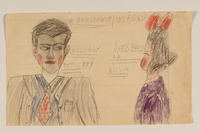
Color portraits of a father and his daughter created by a hidden child
Object
Pastel portrait sketches of Ilona and her father created by Ilona Goldman around 1945. During the war, Ilona lived in hiding in Poland from 1942-1944. She made many drawings during this time, especially when, in spring 1942 at age four, she was separated from her parents and placed with the Polish peasant family of Hania Seremet, who agreed to hide her for a fee. These drawings were the only way for the talkative child, not yet able to write, to communicate with her parents. After Nazi Germany invaded Poland in September 1939, Ilona with her parents, Salomon and Gusta, fled Krakow for Soviet controlled Lvov (Lviv, Ukraine). When Germany invaded the Soviet Union in 1941, the family was forced into the Jewish ghetto where Salomon worked as an accountant at a meat rendering factory owned by the Wehrmacht. In spring 1942, fearing the liquidation of the ghetto, Salomon arranged a hiding place for them outside the ghetto with a former employee, Jozef Jozak. However, he would not hide Ilona because it would be too hard to conceal a lively young girl. Ilona was smuggled to the countryside and placed in hiding as a Christian child with the Seremets. After 6 months, Salomon could no longer pay for her care, so Ilona was brought back to live in their hiding place, without the knowledge of the Jozak family. Ilona had to stay most of this time locked in a closet with only her drawings and the medical textbooks left by a previous tenant. The family lived in hiding until the Soviet Army liberated the city in July 1944. When the war ended in May 1945, they returned to Krakow.
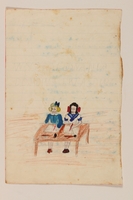
Color drawing of a two girls seated at the same desk created by a former hidden child
Object
Colored pencil drawing of two girls seated at a desk doing schoolwork created by 10 year old Ilona Goldman in 1947. During the war, Ilona lived in hiding in Poland from 1942-1944. She made many drawings during this time, especially when, in spring 1942 at age four, she was separated from her parents and placed with the Polish peasant family of Hania Seremet, who agreed to hide her for a fee. These drawings were the only way for the talkative child, not yet able to write, to communicate with her parents. After Nazi Germany invaded Poland in September 1939, Ilona with her parents, Salomon and Gusta, fled Krakow for Soviet controlled Lvov (Lviv, Ukraine). When Germany invaded the Soviet Union in 1941, the family was forced into the Jewish ghetto where Salomon worked as an accountant at a meat rendering factory owned by the Wehrmacht. In spring 1942, fearing the liquidation of the ghetto, Salomon arranged a hiding place for them outside the ghetto with a former employee, Jozef Jozak. However, he would not hide Ilona because it would be too hard to conceal a lively young girl. Ilona was smuggled to the countryside and placed in hiding as a Christian child with the Seremets. After 6 months, Salomon could no longer pay for her care, so Ilona was brought back to live in their hiding place, without the knowledge of the Jozak family. Ilona had to stay most of this time locked in a closet with only her drawings and the medical textbooks left by a previous tenant. The family lived in hiding until the Soviet Army liberated the city in July 1944. When the war ended in May 1945, they returned to Krakow.
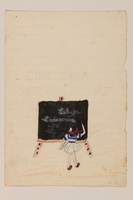
Color drawing of a girl writing on a blackboard created by a former hidden child
Object
Colored pencil drawing of a girl writing on a blackboard created by 10 year old Ilona Goldman in 1947. During the war, Ilona lived in hiding in Poland from 1942-1944. She made many drawings during this time, especially when, in spring 1942 at age four, she was separated from her parents and placed with the Polish peasant family of Hania Seremet, who agreed to hide her for a fee. These drawings were the only way for the talkative child, not yet able to write, to communicate with her parents. After Nazi Germany invaded Poland in September 1939, Ilona with her parents, Salomon and Gusta, fled Krakow for Soviet controlled Lvov (Lviv, Ukraine). When Germany invaded the Soviet Union in 1941, the family was forced into the Jewish ghetto where Salomon worked as an accountant at a meat rendering factory owned by the Wehrmacht. In spring 1942, fearing the liquidation of the ghetto, Salomon arranged a hiding place for them outside the ghetto with a former employee, Jozef Jozak. However, he would not hide Ilona because it would be too hard to conceal a lively young girl. Ilona was smuggled to the countryside and placed in hiding as a Christian child with the Seremets. After 6 months, Salomon could no longer pay for her care, so Ilona was brought back to live in their hiding place, without the knowledge of the Jozak family. Ilona had to stay most of this time locked in a closet with only her drawings and the medical textbooks left by a previous tenant. The family lived in hiding until the Soviet Army liberated the city in July 1944. When the war ended in May 1945, they returned to Krakow.
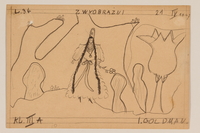
Double-sided sketch of a girl in a traditional Polish peasant costume created by a former hidden child
Object
2-sided pencil portrait of a girl in traditional folk dress on the front and a similar girl and a flute player on the back created by 10 year old Ilona Goldman in 1947. During the war, Ilona lived in hiding in Poland from 1942-1944. She made many drawings during this time, especially when, in spring 1942 at age four, she was separated from her parents and placed with the Polish peasant family of Hania Seremet, who agreed to hide her for a fee. These drawings were the only way for the talkative child, not yet able to write, to communicate with her parents. After Nazi Germany invaded Poland in September 1939, Ilona with her parents, Salomon and Gusta, fled Krakow for Soviet controlled Lvov (Lviv, Ukraine). When Germany invaded the Soviet Union in 1941, the family was forced into the Jewish ghetto where Salomon worked as an accountant at a meat rendering factory owned by the Wehrmacht. In spring 1942, fearing the liquidation of the ghetto, Salomon arranged a hiding place for them outside the ghetto with a former employee, Jozef Jozak. However, he would not hide Ilona because it would be too hard to conceal a lively young girl. Ilona was smuggled to the countryside and placed in hiding as a Christian child with the Seremets. After 6 months, Salomon could no longer pay for her care, so Ilona was brought back to live in their hiding place, without the knowledge of the Jozak family. Ilona had to stay most of this time locked in a closet with only her drawings and the medical textbooks left by a previous tenant. The family lived in hiding until the Soviet Army liberated the city in July 1944. When the war ended in May 1945, they returned to Krakow.
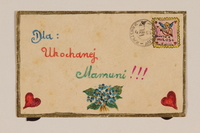
Envelope decorated with hearts and a hand drawn canceled stamp created by a former hidden child
Object
Small envelope decorated with hearts and a handdrawn canceled postage stamp created by 15 year old Ilona Goldman in 1952. During the war, Ilona lived in hiding in Poland from 1942-1944. She made many drawings during this time, especially when, in spring 1942 at age four, she was separated from her parents and placed with the Polish peasant family of Hania Seremet, who agreed to hide her for a fee. These drawings were the only way for the talkative child, not yet able to write, to communicate with her parents. After Nazi Germany invaded Poland in September 1939, Ilona with her parents, Salomon and Gusta, fled Krakow for Soviet controlled Lvov (Lviv, Ukraine). When Germany invaded the Soviet Union in 1941, the family was forced into the Jewish ghetto where Salomon worked as an accountant at a meat rendering factory owned by the Wehrmacht. In spring 1942, fearing the liquidation of the ghetto, Salomon arranged a hiding place for them outside the ghetto with a former employee, Jozef Jozak. However, he would not hide Ilona because it would be too hard to conceal a lively young girl. Ilona was smuggled to the countryside and placed in hiding as a Christian child with the Seremets. After 6 months, Salomon could no longer pay for her care, so Ilona was brought back to live in their hiding place, without the knowledge of the Jozak family. Ilona had to stay most of this time locked in a closet with only her drawings and the medical textbooks left by a previous tenant. The family lived in hiding until the Soviet Army liberated the city in July 1944. When the war ended in May 1945, they returned to Krakow.
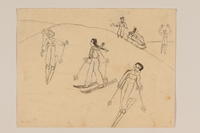
Pencil drawing of children skiing and sledding created by a hidden child
Object
Double sided drawing of children skiing and sledding created Ilona Goldman after the war. There is an unfinished sketch of a house on the reverse. During the war, Ilona lived in hiding in Poland from 1942-1944. She made many drawings during this time, especially when, in spring 1942 at age four, she was separated from her parents and placed with the Polish peasant family of Hania Seremet, who agreed to hide her for a fee. These drawings were the only way for the talkative child, not yet able to write, to communicate with her parents. After Nazi Germany invaded Poland in September 1939, Ilona with her parents, Salomon and Gusta, fled Krakow for Soviet controlled Lvov (Lviv, Ukraine). When Germany invaded the Soviet Union in 1941, the family was forced into the Jewish ghetto where Salomon worked as an accountant at a meat rendering factory owned by the Wehrmacht. In spring 1942, fearing the liquidation of the ghetto, Salomon arranged a hiding place for them outside the ghetto with a former employee, Jozef Jozak. However, he would not hide Ilona because it would be too hard to conceal a lively young girl. Ilona was smuggled to the countryside and placed in hiding as a Christian child with the Seremets. After 6 months, Salomon could no longer pay for her care, so Ilona was brought back to live in their hiding place, without the knowledge of the Jozak family. Ilona had to stay most of this time locked in a closet with only her drawings and the medical textbooks left by a previous tenant. The family lived in hiding until the Soviet Army liberated the city in July 1944. When the war ended in May 1945, they returned to Krakow.
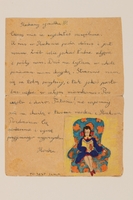
Letter with a color drawing of a girl in a chair sent by a former hidden child
Object
Letter with a small drawing of a girl with a book by 6 year old Ilona Goldman and her mother Gusta to her father Salomon in 1948-1949 when he was away on a business trip. Ilona drew herself sitting in the chair complaining about the rain in Krakow and that she was home from school because she was a bit sick. She misses Daddy very much and hopes he rests well. Her mother reports on daily events and sends her love. Ilona lived in hiding from 1942-1944. In spring 1942, at age four, she was separated from her parents and placed with the Polish peasant family of Hania Seremet, who agreed to hide her for a fee. Drawings were the only way for the talkative child, not yet able to write, to communicate with her parents. After Nazi Germany invaded Poland in September 1939, Ilona and her parents fled Krakow for Soviet controlled Lvov (Lviv, Ukraine). When Germany invaded the Soviet Union in 1941, the family was forced into the Jewish ghetto where Salomon worked as an accountant at a meat rendering factory owned by the Wehrmacht. In spring 1942, fearing the liquidation of the ghetto, Salomon arranged a hiding place for them outside the ghetto with a former employee, Jozef Jozak. However, he would not hide Ilona because it would be too hard to conceal a lively young girl. Ilona was smuggled to the countryside and placed in hiding as a Christian child with the Seremets. After 6 months, Salomon could no longer pay for her care, so Ilona was brought back to live in their hiding place, without the knowledge of the Jozak family. Ilona had to stay most of this time locked in a closet with only her drawings and the medical textbooks left by a previous tenant. The family lived in hiding until the Soviet Army liberated the city in July 1944. When the war ended in May 1945, they returned to Krakow.
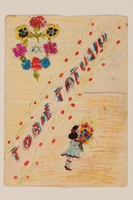
Birthday card with a picture of a little girl made for her father by a former hidden child
Object
Birthday card with an image of a little girl with flowers and a message made for her father by 11 year Ilona Goldman in July 1948. During the war, Ilona lived in hiding in Poland from 1942-1944. She made many drawings during this time, especially when, in spring 1942 at age four, she was separated from her parents and placed with the Polish peasant family of Hania Seremet, who agreed to hide her for a fee. These drawings were the only way for the talkative child, not yet able to write, to communicate with her parents. After Nazi Germany invaded Poland in September 1939, Ilona with her parents, Salomon and Gusta, fled Krakow for Soviet controlled Lvov (Lviv, Ukraine). When Germany invaded the Soviet Union in 1941, the family was forced into the Jewish ghetto where Salomon worked as an accountant at a meat rendering factory owned by the Wehrmacht. In spring 1942, fearing the liquidation of the ghetto, Salomon arranged a hiding place for them outside the ghetto with a former employee, Jozef Jozak. However, he would not hide Ilona because it would be too hard to conceal a lively young girl. Ilona was smuggled to the countryside and placed in hiding as a Christian child with the Seremets. After 6 months, Salomon could no longer pay for her care, so Ilona was brought back to live in their hiding place, without the knowledge of the Jozak family. Ilona had to stay most of this time locked in a closet with only her drawings and the medical textbooks left by a previous tenant. The family lived in hiding until the Soviet Army liberated the city in July 1944. When the war ended in May 1945, they returned to Krakow.
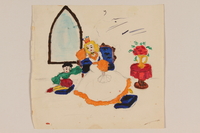
Watercolor of a woman with a crown near a child kneeling on a pillow created by a former hidden child
Object
Watercolor of a seated princess and a kneeling child created by Ilona Goldman circa 1948. During the war, Ilona lived in hiding in Poland from 1942-1944. She made many drawings during this time, especially when, in spring 1942 at age four, she was separated from her parents and placed with the Polish peasant family of Hania Seremet, who agreed to hide her for a fee. These drawings were the only way for the talkative child, not yet able to write, to communicate with her parents. After Nazi Germany invaded Poland in September 1939, Ilona with her parents, Salomon and Gusta, fled Krakow for Soviet controlled Lvov (Lviv, Ukraine). When Germany invaded the Soviet Union in 1941, the family was forced into the Jewish ghetto where Salomon worked as an accountant at a meat rendering factory owned by the Wehrmacht. In spring 1942, fearing the liquidation of the ghetto, Salomon arranged a hiding place for them outside the ghetto with a former employee, Jozef Jozak. However, he would not hide Ilona because it would be too hard to conceal a lively young girl. Ilona was smuggled to the countryside and placed in hiding as a Christian child with the Seremets. After 6 months, Salomon could no longer pay for her care, so Ilona was brought back to live in their hiding place, without the knowledge of the Jozak family. Ilona had to stay most of this time locked in a closet with only her drawings and the medical textbooks left by a previous tenant. The family lived in hiding until the Soviet Army liberated the city in July 1944. When the war ended in May 1945, they returned to Krakow.

Watercolor of a princess in a red and green gown created by a former hidden child
Object
Watercolor of a crowned, dark haired woman in a red and green gown created by 11 year old Ilona Goldman in 1948. There is a sketch of the lady's face on the back. During the war, Ilona lived in hiding in Poland from 1942-1944. She made many drawings during this time, especially when, in spring 1942 at age four, she was separated from her parents and placed with the Polish peasant family of Hania Seremet, who agreed to hide her for a fee. These drawings were the only way for the talkative child, not yet able to write, to communicate with her parents. After Nazi Germany invaded Poland in September 1939, Ilona with her parents, Salomon and Gusta, fled Krakow for Soviet controlled Lvov (Lviv, Ukraine). When Germany invaded the Soviet Union in 1941, the family was forced into the Jewish ghetto where Salomon worked as an accountant at a meat rendering factory owned by the Wehrmacht. In spring 1942, fearing the liquidation of the ghetto, Salomon arranged a hiding place for them outside the ghetto with a former employee, Jozef Jozak. However, he would not hide Ilona because it would be too hard to conceal a lively young girl. Ilona was smuggled to the countryside and placed in hiding as a Christian child with the Seremets. After 6 months, Salomon could no longer pay for her care, so Ilona was brought back to live in their hiding place, without the knowledge of the Jozak family. Ilona had to stay most of this time locked in a closet with only her drawings and the medical textbooks left by a previous tenant. The family lived in hiding until the Soviet Army liberated the city in July 1944. When the war ended in May 1945, they returned to Krakow.
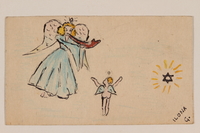
Small watercolor with an angel, a cherubim and a Star of David created by a former hidden child
Object
Watercolor drawing with a winged cherubim gazing at an angel blowing a shofar created by Ilona Goldman after the war. During the war, Ilona lived in hiding in Poland from 1942-1944. She made many drawings during this time, especially when, in spring 1942 at age four, she was separated from her parents and placed with the Polish peasant family of Hania Seremet, who agreed to hide her for a fee. These drawings were the only way for the talkative child, not yet able to write, to communicate with her parents. After Nazi Germany invaded Poland in September 1939, Ilona with her parents, Salomon and Gusta, fled Krakow for Soviet controlled Lvov (Lviv, Ukraine). When Germany invaded the Soviet Union in 1941, the family was forced into the Jewish ghetto where Salomon worked as an accountant at a meat rendering factory owned by the Wehrmacht. In spring 1942, fearing the liquidation of the ghetto, Salomon arranged a hiding place for them outside the ghetto with a former employee, Jozef Jozak. However, he would not hide Ilona because it would be too hard to conceal a lively young girl. Ilona was smuggled to the countryside and placed in hiding as a Christian child with the Seremets. After 6 months, Salomon could no longer pay for her care, so Ilona was brought back to live in their hiding place, without the knowledge of the Jozak family. Ilona had to stay most of this time locked in a closet with only her drawings and the medical textbooks left by a previous tenant. The family lived in hiding until the Soviet Army liberated the city in July 1944. When the war ended in May 1945, they returned to Krakow.
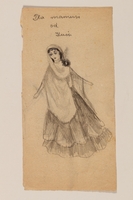
Double-sided drawing of a beautiful costumed woman and a costumed man sketched by a hidden child
Object
Two-sided pencil drawing of a woman with a veil and gown created by Ilona Goldman. On the back is an unfinished sketch of a bearded man in a mitre and fur trimmed outfit, possibly Kris Kringle or a priest. During the war, Ilona lived in hiding from 1942-1944. In spring 1942, Ilona was separated from her parents and placed with the Polish peasant family of Hania Seremet, who agreed to hide her for a fee. Drawings were the only way for the talkative child, not yet able to write, to communicate with her parents. After Nazi Germany invaded Poland in September 1939, lona with her parents, Salomon and Gusta, fled Krakow for Soviet controlled Lvov (Lviv, Ukraine). When Germany invaded the Soviet Union in 1941, the family was forced into the Jewish ghetto where Salomon worked as an accountant at a meat rendering factory owned by the Wehrmacht. In spring 1942, fearing the liquidation of the ghetto, Salomon arranged a hiding place for them outside the ghetto with a former employee, Jozef Jozak. However, he would not hide Ilona because it would be too hard to conceal a lively 4 year-old. Ilona was smuggled to the countryside and placed in hiding as a Christian child with a Polish woman paid to hide her. After 6 months, Salomon could no longer pay for her care, so Ilona was brought back to live in their hiding place, without the knowledge of the Jozak family. Ilona had to stay most of this time locked in a closet with only her drawings and the medical textbooks left by a previous tenant. The family lived in hiding until the Soviet Army liberated the city in July 1944. When the war ended in May 1945, they returned to Krakow.
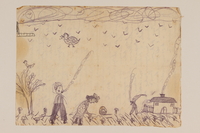
Birthday letter with a color drawing of a mushroom garden by a hidden child
Object
Birthday story with a drawing of a couple picking mushrooms with a gnome created by 7 year old Ilona Goldman and her mother while in hiding in Lvov, Poland (L'viv, Ukraine) July 4, 1944. Ilona dictated this story to her mother as a gift for her father's birthday. Both of Ilona's parents suffered from the lack of cigarettes. The gnome, the man, and the house are all smoking and in the drawing Ilona wished her parents could have as many cigarettes as they wanted. The story tells of a boy and girl seeing a gnome's house near the forest, a witch on a broom, and the girl's worrying that she had no basket to gather mushrooms. Ilona lived in hiding in Poland from 1942-1944. In spring 1942, at age four, she was separated from her parents and placed with the Polish peasant family of Hania Seremet, who agreed to hide her for a fee. Drawings were the only way for the talkative child, not yet able to write, to communicate with her parents. After Nazi Germany invaded Poland in September 1939, Ilona with her parents, Salomon and Gusta, fled Krakow for Soviet controlled Lvov. When Germany invaded the Soviet Union in 1941, the family was forced into the Jewish ghetto where Salomon worked as an accountant at a factory owned by the Wehrmacht. In spring 1942, fearing the liquidation of the ghetto, Salomon arranged a hiding place for them outside the ghetto with a former employee, Jozef Jozak. However, he would not hide Ilona because it would be too hard to conceal a lively young girl. Ilona was smuggled to the countryside and placed in hiding as a Christian child with the Seremets. After 6 months, Salomon could no longer pay for her care, so Ilona was brought back to live in their hiding place, without the knowledge of the Jozak family. Ilona had to stay most of this time locked in a closet with only her drawings and the medical textbooks left by a previous tenant. The family lived in hiding until the Soviet Army liberated the city in July 1944. When the war ended in May 1945, they returned to Krakow.
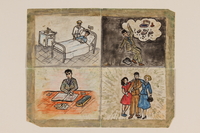
Four cartoon panels telling the story of man injured in a robbery created by a former hidden child
Object
Four cartoon panels depicting the story of a man injured in a robbery created by Ilona Goldman after the war. During the war, Ilona lived in hiding in Poland from 1942-1944. She made many drawings during this time, especially when, at age four, she was separated from her parents and placed with the Polish peasant family of Hania Seremet, who agreed to hide her for a fee. These drawings were the only way for the talkative child, not yet able to write, to communicate with her parents. After Nazi Germany invaded Poland in September 1939, Alona's parents, Salomon and Gusta, with Alona, fled Krakow for the Russian controlled city of Lvov (Lviv, Ukraine). When Germany invaded the Soviet Union in 1941, the family was forced into the Jewish ghetto where Salomon worked as an accountant at a meat rendering factory owned by the Wehrmacht. In spring 1942, fearing the liquidation of the ghetto, Salomon arranged a hiding place for them outside the ghetto with a former employee, Jozef Jozak, and his family. However, they would not hide Ilona because they thought it would be too hard to conceal a lively young girl. Ilona was smuggled to the countryside and placed in hiding as a Christian child with the Seremets. After 6 months, Salomon could no longer pay for her care, so Ilona was brought back to live in their hiding place, without the knowledge of the Jozak family. Ilona had to stay most of this time locked in a closet with only her drawings and the medical textbooks left by a previous tenant. The family lived in hiding until the Soviet Army liberated the city in July 1944. When the war ended in May 1945, they returned to Krakow..
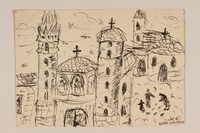
Ink drawing of a cityscape with three churches created by a hidden child
Object
Ink drawing of a row of buildings created by Ilona Goldman about 1949. During the war, Ilona lived in hiding in Poland from 1942-1944. She made many drawings during this time, especially when, at age four, she was separated from her parents and placed with the Polish peasant family of Hania Seremet, who agreed to hide her for a fee. These drawings were the only way for the talkative child, not yet able to write, to communicate with her parents. After Nazi Germany invaded Poland in September 1939, Alona's parents, Salomon and Gusta, with Alona, fled Krakow for the Russian controlled city of Lvov (Lviv, Ukraine). When Germany invaded the Soviet Union in 1941, the family was forced into the Jewish ghetto where Salomon worked as an accountant at a meat rendering factory owned by the Wehrmacht. In spring 1942, fearing the liquidation of the ghetto, Salomon arranged a hiding place for them outside the ghetto with a former employee, Jozef Jozak, and his family. However, they would not hide Ilona because they thought it would be too hard to conceal a lively young girl. Ilona was smuggled to the countryside and placed in hiding as a Christian child with the Seremets. After 6 months, Salomon could no longer pay for her care, so Ilona was brought back to live in their hiding place, without the knowledge of the Jozak family. Ilona had to stay most of this time locked in a closet with only her drawings and the medical textbooks left by a previous tenant. The family lived in hiding until the Soviet Army liberated the city in July 1944. When the war ended in May 1945, they returned to Krakow.
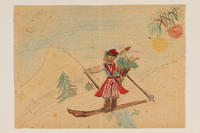
Two-sided color drawing of a girl on skis created by a hidden child
Object
Double-sided drawing of a girl skiing on one side and a sketch of a hatchet on the back done by Ilona Goldman around 1947. During the war, Ilona lived in hiding in Poland from 1942-1944. She made many drawings during this time, especially when, in spring 1942 at age four, she was separated from her parents and placed with the Polish peasant family of Hania Seremet, who agreed to hide her for a fee. These drawings were the only way for the talkative child, not yet able to write, to communicate with her parents. After Nazi Germany invaded Poland in September 1939, Ilona with her parents, Salomon and Gusta, fled Krakow for Soviet controlled Lvov (Lviv, Ukraine). When Germany invaded the Soviet Union in 1941, the family was forced into the Jewish ghetto where Salomon worked as an accountant at a meat rendering factory owned by the Wehrmacht. In spring 1942, fearing the liquidation of the ghetto, Salomon arranged a hiding place for them outside the ghetto with a former employee, Jozef Jozak. However, he would not hide Ilona because it would be too hard to conceal a lively young girl. Ilona was smuggled to the countryside and placed in hiding as a Christian child with the Seremets. After 6 months, Salomon could no longer pay for her care, so Ilona was brought back to live in their hiding place, without the knowledge of the Jozak family. Ilona had to stay most of this time locked in a closet with only her drawings and the medical textbooks left by a previous tenant. The family lived in hiding until the Soviet Army liberated the city in July 1944. When the war ended in May 1945, they returned to Krakow.
Alona Frankel papers
Document
Original photographs: images of Goldman and Gruber families before the war in Oświęcim, Bochnia and Krakow, Poland; includes images of Salomon, Gusta and Ilona Goldman after the war in Krakow and later in Israel; Documents and correspondence: Salomon, Gusta and Ilona Goldman’s genuine and false ID’s and wartime letters; Drawings: by Ilona Goldman [donor] while in hiding and after the war; Maps: from newspapers on which Salomon Goldman marked the advancement of the Red Army.
Book
Object
One of the few books three year old Ilona Goldman had to look at while she lived in hiding in a small room with her parents from late 1942-July 1944. The room had been the office of a Jewish gynecologist who was deported with his family and killed in a camp. Ilona felt the books saved her from life where the daily reality was that their Ukrainian and Polish neighbors, as well as the German soldiers, wanted to kill them. Soon after Nazi Germany invaded Poland in September 1939, Gusta and Salomon, with two year old, Ilona, fled Krakow for Russian controlled Lvov (Lviv, Ukraine). When Germany invaded the Soviet Union in 1941, the family was forced into the ghetto. Salomon worked as an accountant at a factory owned by the Wehrmacht. In the spring of 1942, fearing the liquidation of the ghetto, Salomon arranged a hiding place for them outside the ghetto with a former employee, Jozef Jozak. However, he would not hide Ilona because it would be too hard to conceal a lively 2 year-old child. Ilona was smuggled out to the countryside and placed in hiding as a Christian child, with a Polish woman, Hania Seremet, who was paid to hide her. After 6 months, they could no longer pay for her care, and Hania dumped Ilona back with her parents, without the knowledge of the Jozak family. The three had to stay hidden nearly all the time in one small room. The family lived in hiding until the Soviet Army liberated the city in July 1944. When the was ended in May 1945, they returned to Krakow.
Book
Object
One of the few books three year old Ilona Goldman had to look at while she lived in hiding in a small room with her parents from late 1942-July 1944. The room had been the office of a Jewish gynecologist who was deported with his family and killed in a camp. Ilona felt the books saved her from life where the daily reality was that their Ukrainian and Polish neighbors, as well as the German soldiers, wanted to kill them. Soon after Nazi Germany invaded Poland in September 1939, Gusta and Salomon, with two year old, Ilona, fled Krakow for Russian controlled Lvov (Lviv, Ukraine). When Germany invaded the Soviet Union in 1941, the family was forced into the ghetto. Salomon worked as an accountant at a factory owned by the Wehrmacht. In the spring of 1942, fearing the liquidation of the ghetto, Salomon arranged a hiding place for them outside the ghetto with a former employee, Jozef Jozak. However, he would not hide Ilona because it would be too hard to conceal a lively 2 year-old child. Ilona was smuggled out to the countryside and placed in hiding as a Christian child, with a Polish woman, Hania Seremet, who was paid to hide her. After 6 months, they could no longer pay for her care, and Hania dumped Ilona back with her parents, without the knowledge of the Jozak family. The three had to stay hidden nearly all the time in one small room. The family lived in hiding until the Soviet Army liberated the city in July 1944. When the was ended in May 1945, they returned to Krakow.
Book
Object
One of the few books three year old Ilona Goldman had to look at while she lived in hiding in a small room with her parents from late 1942-July 1944. The room had been the office of a Jewish gynecologist who was deported with his family and killed in a camp. Ilona felt the books saved her from life where the daily reality was that their Ukrainian and Polish neighbors, as well as the German soldiers, wanted to kill them. Soon after Nazi Germany invaded Poland in September 1939, Gusta and Salomon, with two year old, Ilona, fled Krakow for Russian controlled Lvov (Lviv, Ukraine). When Germany invaded the Soviet Union in 1941, the family was forced into the ghetto. Salomon worked as an accountant at a factory owned by the Wehrmacht. In the spring of 1942, fearing the liquidation of the ghetto, Salomon arranged a hiding place for them outside the ghetto with a former employee, Jozef Jozak. However, he would not hide Ilona because it would be too hard to conceal a lively 2 year-old child. Ilona was smuggled out to the countryside and placed in hiding as a Christian child, with a Polish woman, Hania Seremet, who was paid to hide her. After 6 months, they could no longer pay for her care, and Hania dumped Ilona back with her parents, without the knowledge of the Jozak family. The three had to stay hidden nearly all the time in one small room. The family lived in hiding until the Soviet Army liberated the city in July 1944. When the was ended in May 1945, they returned to Krakow.
Book
Object
One of the few books three year old Ilona Goldman had to look at while she lived in hiding in a small room with her parents from late 1942-July 1944. The room had been the office of a Jewish gynecologist who was deported with his family and killed in a camp. Ilona felt the books saved her from life where the daily reality was that their Ukrainian and Polish neighbors, as well as the German soldiers, wanted to kill them. Soon after Nazi Germany invaded Poland in September 1939, Gusta and Salomon, with two year old, Ilona, fled Krakow for Russian controlled Lvov (Lviv, Ukraine). When Germany invaded the Soviet Union in 1941, the family was forced into the ghetto. Salomon worked as an accountant at a factory owned by the Wehrmacht. In the spring of 1942, fearing the liquidation of the ghetto, Salomon arranged a hiding place for them outside the ghetto with a former employee, Jozef Jozak. However, he would not hide Ilona because it would be too hard to conceal a lively 2 year-old child. Ilona was smuggled out to the countryside and placed in hiding as a Christian child, with a Polish woman, Hania Seremet, who was paid to hide her. After 6 months, they could no longer pay for her care, and Hania dumped Ilona back with her parents, without the knowledge of the Jozak family. The three had to stay hidden nearly all the time in one small room. The family lived in hiding until the Soviet Army liberated the city in July 1944. When the was ended in May 1945, they returned to Krakow.
Book
Object
Ilona's favorite of the few books the three year old Ilona Goldman had to look at while living in hiding in a small room with her parents from late 1942-July 1944. The room had been the office of a Jewish gynecologist who was deported with his family and killed in a camp. Ilona felt the books saved her from life where the daily reality was that their Ukrainian and Polish neighbors, as well as the German soldiers, wanted to kill them. Soon after Nazi Germany invaded Poland in September 1939, Gusta and Salomon, with two year old, Ilona, fled Krakow for Russian controlled Lvov (Lviv, Ukraine). When Germany invaded the Soviet Union in 1941, the family was forced into the ghetto. Salomon worked as an accountant at a factory owned by the Wehrmacht. In the spring of 1942, fearing the liquidation of the ghetto, Salomon arranged a hiding place for them outside the ghetto with a former employee, Jozef Jozak. However, he would not hide Ilona because it would be too hard to conceal a lively 2 year-old child. Ilona was smuggled out to the countryside and placed in hiding as a Christian child, with a Polish woman, Hania Seremet, who was paid to hide her. After 6 months, they could no longer pay for her care, and Hania dumped Ilona back with her parents, without the knowledge of the Jozak family. The three had to stay hidden nearly all the time in one small room. The family lived in hiding until the Soviet Army liberated the city in July 1944. When the was ended in May 1945, they returned to Krakow.
Book
Object
One of the few books three year old Ilona Goldman had to look at while she lived in hiding in a small room with her parents from late 1942-July 1944. The room had been the office of a Jewish gynecologist who was deported with his family and killed in a camp. Ilona felt the books saved her from life where the daily reality was that their Ukrainian and Polish neighbors, as well as the German soldiers, wanted to kill them. Soon after Nazi Germany invaded Poland in September 1939, Gusta and Salomon, with two year old, Ilona, fled Krakow for Russian controlled Lvov (Lviv, Ukraine). When Germany invaded the Soviet Union in 1941, the family was forced into the ghetto. Salomon worked as an accountant at a factory owned by the Wehrmacht. In the spring of 1942, fearing the liquidation of the ghetto, Salomon arranged a hiding place for them outside the ghetto with a former employee, Jozef Jozak. However, he would not hide Ilona because it would be too hard to conceal a lively 2 year-old child. Ilona was smuggled out to the countryside and placed in hiding as a Christian child, with a Polish woman, Hania Seremet, who was paid to hide her. After 6 months, they could no longer pay for her care, and Hania dumped Ilona back with her parents, without the knowledge of the Jozak family. The three had to stay hidden nearly all the time in one small room. The family lived in hiding until the Soviet Army liberated the city in July 1944. When the was ended in May 1945, they returned to Krakow.
Book
Object
Cookbook given by Salomon Goldman to his bride, Gusta Gruber, as a wedding gift in 1936. They kept this book with them while in hiding in Lvov, Poland, from 1942-1944. They were always hungry and, as a diversion, every day Gusta dictated an elaborate menu which Salomon recorded n a notebook. She never repeated a menu and they sometimes used this cookbook for ideas. After Germany invaded Poland in September 1939, Gusta and Salomon, with 2 year old Ilona, fled Krakow for Russian controlled Lvov (Lviv, Ukraine). When Germany invaded the Soviet Union in 1941, the family was forced into the ghetto where Salomon worked as an accountant at a factory owned by the Wehrmacht. In spring 1942, fearing liquidation of the ghetto, Salomon arranged a hiding place for them with a former employee, Jozef Jozak. He would not hide Ilona because it would be too hard to conceal a lively 2 year-old child. Ilona was smuggled out to the countryside and placed in hiding as a Christian child, with a Polish woman, Hania Seremet, paid to hide her. After 6 months, they could no longer pay for her care, and Hania dumped Ilona with them at their hiding place, without the knowledge of the Jozaks. They lived all this time in one room until the Soviet Army liberated the city in July 1944. When the was ended in May 1945, they returned to Krakow.
Book
Object
Soon after Nazi Germany invaded Poland in September 1939, Gusta and Salomon Frankel, with 2 year old Ilona, fled Krakow for the Russian controlled Lvov. When Germany invaded the Soviet Union in 1941, the family was forced into the ghetto where Salomon worked as an accountant at a factory owned by the Wehrmacht. In the spring of 1942, fearing the liquidation of the ghetto, Salomon arranged a hiding place for them outside the ghetto with a former employee, Jozef Jozak. However, He would not hide Ilona because it would be too hard to conceal a lively 4 year-old child. Ilona was smuggled out to the countryside and placed in hiding as a Christian child, with a Polish woman who was paid to hide her. After 6 months, they could no longer pay for her care, so they had to bring Ilona back to live in their hiding place, without the knowledge of the Jozak family. Ilona had to stay most of this time locked in a closet with only her drawings and medical textbooks left by a previous tenant. The family lived in hiding until the Soviet Army liberated the city in July 1944. When the was ended in May 1945, they returned to Krakow.



